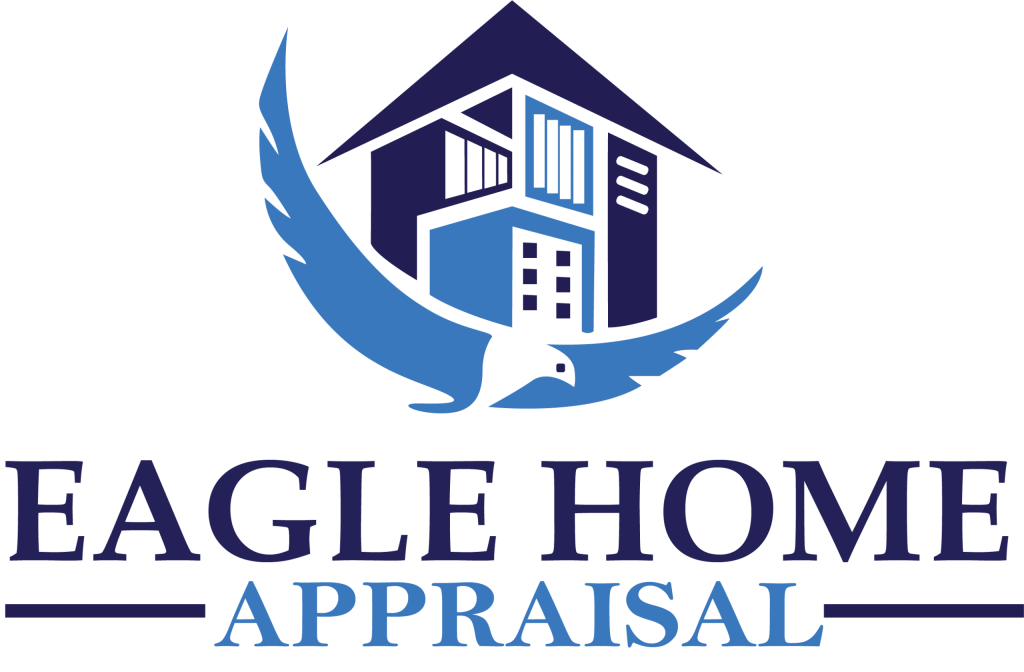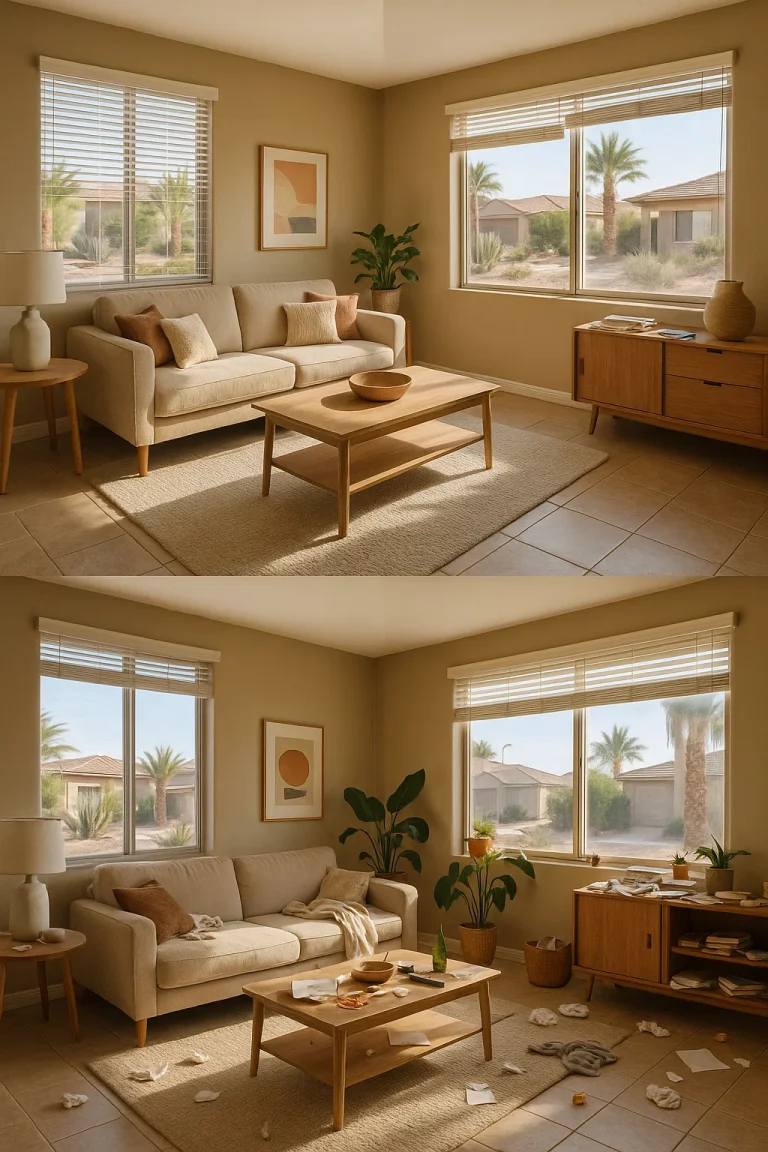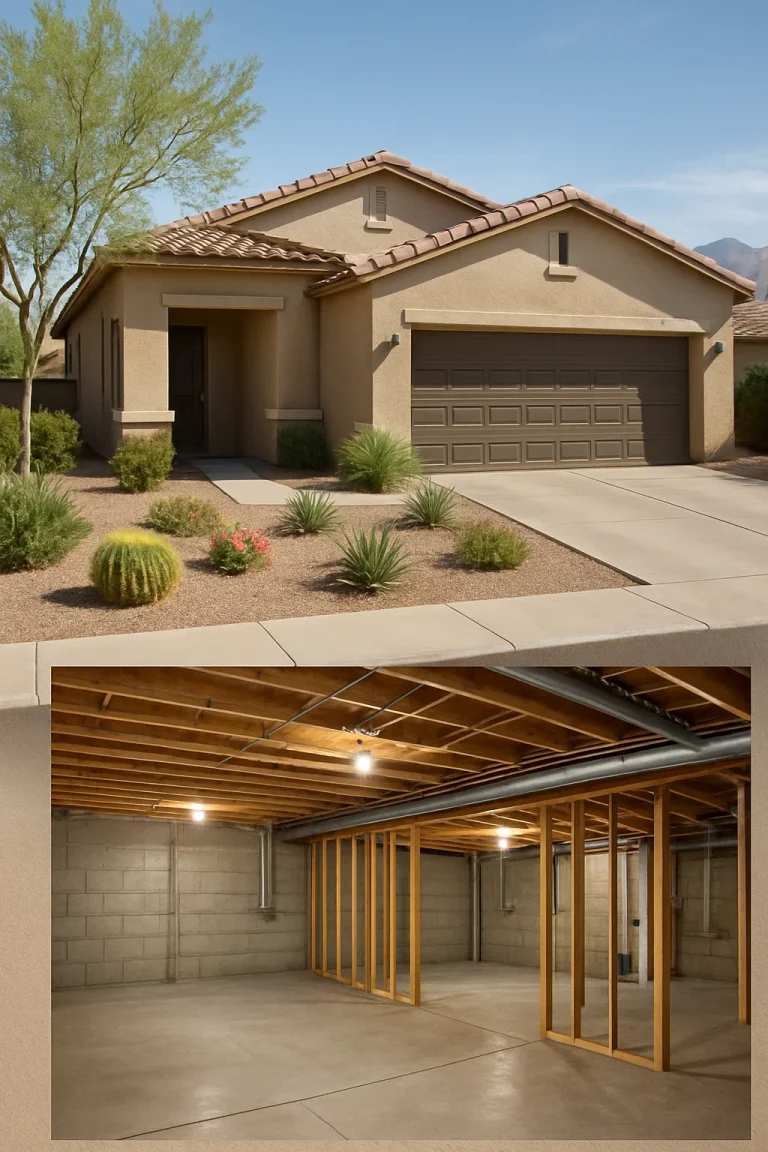Can Clutter Or Poor Housekeeping Affect A Gilbert Home Appraisal?
 A home appraisal is one of the most critical moments in any real estate transaction—whether you’re buying, selling, refinancing, or navigating legal matters like divorce or estate planning. For property owners in Gilbert, Arizona, where home values have climbed steadily due to rapid development and desirable community amenities, the appraisal’s outcome can significantly impact financial decisions.
A home appraisal is one of the most critical moments in any real estate transaction—whether you’re buying, selling, refinancing, or navigating legal matters like divorce or estate planning. For property owners in Gilbert, Arizona, where home values have climbed steadily due to rapid development and desirable community amenities, the appraisal’s outcome can significantly impact financial decisions.
A common question homeowners ask before an appraisal is whether clutter, cleanliness, or general disorganization can lower their home’s appraised value. While professional appraisers focus primarily on measurable factors—such as square footage, location, lot size, building materials, and comparable sales—presentation can indirectly influence an appraiser’s perception of maintenance, upkeep, and the home’s overall condition.
At Eagle Home Appraisal Gilbert, we’ve appraised thousands of homes across the region and have seen firsthand how cleanliness, maintenance, and organization contribute to the impression of property care. In this comprehensive guide, we’ll explore the relationship between clutter and appraised value, provide actionable advice for preparing your home, and clarify how appraisers evaluate a property beyond its surface appearance.
What an Appraiser Actually Looks For
When conducting a home appraisal, a certified real estate appraiser’s primary responsibility is to determine fair market value. This professional assessment is guided by federal and state appraisal standards, ensuring impartiality and consistency.
Appraisers do not “grade” cleanliness in the same subjective sense as a potential buyer might, nor are they swayed by minor aesthetic issues. However, clutter or poor housekeeping can obscure important aspects of the property that directly factor into valuation.
Key components of an appraisal include:
- Location and Surroundings: Proximity to schools, shopping, parks, and transportation.
- Structural Integrity: Foundation stability, roof condition, and evidence of water or termite damage.
- Interior and Exterior Features: Flooring, cabinetry, windows, plumbing, HVAC systems, and recent upgrades.
- Functional Layout: Room flow, usable space, and the home’s practicality.
- Comparable Sales (Comps): Market data from nearby recent property sales with similar characteristics.
An appraiser’s job isn’t to penalize unwashed dishes or a few toys scattered around; rather, the concern arises when clutter prevents a clear view of the home’s structure, creates safety hazards, or suggests deferred maintenance that could affect longevity or value. In that sense, appearance becomes a proxy for care—and care is a component that influences long-term property health.
The Psychological Impact of Cleanliness on Perceived Condition
Although the appraisal process is data-driven, human perception plays an undeniable role in any visual inspection. A home that’s cluttered or dirty sends subconscious cues about neglect, while one that’s tidy and well-kept reinforces a perception of responsible ownership.
Psychologically, cleanliness equates to control, order, and pride in ownership—all of which translate into an assumption that other, less visible areas (like plumbing, insulation, or wiring) have been equally maintained. Conversely, extensive clutter may create the impression that maintenance tasks have been repeatedly postponed.
Even when this isn’t factually true, perception shapes the tone of an inspection. When an appraiser walks into a bright, organized, clean home, navigating rooms easily and observing structure without obstacles, the inspection feels efficient and trustworthy. In contrast, excessive mess slows down the process, limits visibility, and can lead to unintentional oversight of key features.
While appraisers must remain impartial, subtle impressions form nonetheless. That’s why cleanliness, although not a formal line item on the appraisal form, indirectly affects how confident the appraiser feels about the property’s overall condition rating—a factor that can influence the valuation baseline.
The Difference Between Clutter and Condition
Many homeowners confuse “clutter” with “condition,” but for an appraiser, these terms represent distinct assessments.
Clutter refers to temporary surface mess, personal belongings, or disorganization that can easily be cleared up. Examples include stacks of magazines, overflowing closets, or crowded countertops. These issues rarely influence value directly because they don’t change the home’s physical structure.
Condition, however, describes the physical state of the property and its systems—how well-built, well-maintained, and structurally sound it is. Peeling paint, cracked tiles, roof leaks, mold, or outdated wiring directly affect market value because they require repair or pose safety risks.
The critical distinction lies in interpretation. If clutter conceals or prevents inspection of structural elements, the appraiser might report “limited visibility” or note that certain areas couldn’t be assessed. That limitation can trigger a conservative approach, where the valuation leans lower due to uncertainty.
In short, clutter itself doesn’t reduce value; the impression or limitations it creates might. Therefore, ensuring an easy-to-view, well-lit, and accessible environment helps your appraiser confidently evaluate your property’s true condition, which can only benefit the final valuation.
Common Areas Where Clutter Interferes with Appraisals
Even with professional objectivity, appraisers depend on clear access to inspect key components of a home. Excessive clutter can unintentionally block those areas, delaying the process or affecting thoroughness.
The most common problem areas include:
- Basements and Garages: Boxes stacked wall to wall can block visibility of foundation walls, signs of moisture, or cracks.
- Utility Rooms: Heavily cluttered mechanical rooms can prevent inspection of furnaces, water heaters, or electrical panels.
- Closets and Storage Spaces: While not major appraisal determinants, they reveal how well the home utilizes space.
- Kitchens and Bathrooms: Overcrowded counters and cabinets may obscure upgrade details, countertop materials, or plumbing condition.
- Exterior Perimeter: Overgrown vegetation, piled debris, or backyard storage can prevent assessment of siding, grading, or drainage patterns.
When an appraiser must speculate about unseen aspects due to blocked access, the report may reflect uncertainty or recommend further inspection—potentially delaying the appraisal or causing lenders to question completeness.
Therefore, before your appraisal appointment, ensure pathways are clear, crucial mechanical elements are visible, and no major area is so cluttered that it obstructs a fair, objective assessment.
How Poor Housekeeping Signals Deferred Maintenance
Poor housekeeping goes beyond clutter—it reflects neglect of routine cleaning, repair, and inspection tasks that preserve property integrity. An appraiser naturally notes visible wear-and-tear that suggests underlying problems.
Think of signs like:
- Stains on walls or ceilings indicative of water intrusion.
- Dirty or neglected HVAC filters implying poor system care.
- Cracked tiles, worn carpet, or damaged paint suggesting deferred renovation.
- Mold or mildew in bathrooms or basements hinting at ventilation issues.
When housekeeping issues overlap with potential physical deterioration, the property’s condition rating drops. Appraisers use standardized categories ranging from C1 (new) to C6 (severe disrepair). A home that shows signs of neglect might be graded as C4 or C5, affecting comparables and lowering estimated market value.
Professional appraisers are trained to differentiate superficial mess from genuine damage. However, consistent disorder often blurs that boundary, inviting conservative valuation. Maintaining functional cleanliness demonstrates proactive ownership—reassuring an appraiser that the home has been continuously cared for.
The Role of Condition Ratings in Appraisal Reports
Condition ratings are one of the most influential aspects of any appraisal report. The Uniform Appraisal Dataset (UAD), used nationwide, defines standardized codes for property condition.
For example:
- C1: Newly constructed, no physical depreciation.
- C2: Recently renovated with no significant defects.
- C3: Well-maintained, normal wear consistent with age.
- C4: Minor deferred maintenance, typically cosmetic issues.
- C5: Obvious deferred maintenance or needed repairs.
- C6: Substantial damage or uninhabitable condition.
Even if clutter doesn’t directly reduce a rating, it can create ambiguity. If an appraiser can’t confidently determine the condition of a surface or system because it’s obscured, they may assume conservative ratings. A small shift—from C3 to C4—might represent thousands of dollars in value difference, depending on the property’s price point.
Thus, clarifying visibility is crucial. Providing access to mechanical systems, ensuring lighting works in every room, and keeping floors visible and pathways clear all contribute to confidence in stronger condition ratings.
How to Prepare Your Home for an Appraisal
Preparing for an appraisal in Gilbert doesn’t require a full renovation, but thoughtful preparation can help your home present at its best.
Key preparation steps include:
- Declutter your living areas: Store nonessential items in bins or neatly organized closets.
- Deep clean: Wipe surfaces, dust light fixtures, vacuum carpets, and clean windows.
- Perform minor repairs: Replace burnt bulbs, tighten hardware, fix dripping faucets.
- Enhance curb appeal: Mow lawns, trim hedges, and clean outdoor debris.
- Document upgrades: Prepare a list of recent improvements, receipts, and warranty details to share with the appraiser.
- Ensure full accessibility: Clear paths to the attic, basement, garage, and all utility equipment.
Presentation demonstrates ownership pride. When an appraiser sees a home that’s orderly, well-lit, and maintained, they approach valuation with assurance that the property’s systems likely reflect similar care.
What Not to Worry About Before an Appraisal
While preparation helps, homeowners often overcompensate by focusing on the wrong details. Appraisers are trained professionals, not housecleaning judges, and their primary concern is structural and market-based.
Don’t stress over:
- Minor scuffs or everyday clutter (a few toys or laundry baskets).
- Seasonal decor or personal photos.
- Unpolished furniture or light cosmetic imperfections.
- Smells from cooking, unless indicative of underlying issues (mold, smoke, etc.).
Over-cleaning or staging can even appear unnatural. Aim for realistic tidiness—functional, comfortable, and representative of normal life. The goal is clarity and accessibility, not perfection.
Appraisers expect occupied homes to look lived-in. The focus should remain on maintenance, safety, and visibility. Once those are addressed, small aesthetic imperfections fade in importance.
Gilbert Market-Specific Considerations
Gilbert’s real estate market is unique—highly competitive, family-oriented, and influenced by rapid suburban development. Because of elevated property values, even subtle differences in appraisal ratings can translate to substantial monetary outcomes.
In a city known for well-maintained neighborhoods and HOA oversight, cleanliness and home care carry symbolic weight. An appraiser evaluating two similar properties—one tidy and one disorganized—may naturally perceive the former as better cared for, influencing their confidence in its comparables.
Furthermore, Gilbert’s climate introduces specific maintenance demands, such as protecting against sun-related fading, HVAC efficiency, and landscape management. Poor housekeeping in arid environments (e.g., dust buildup, faded paint) may imply environmental neglect.
Eagle Home Appraisal Gilbert’s professionals understand these local patterns intimately. We recognize how Gilbert’s housing standards and buyer expectations intersect with appraisal methodology—and we guide homeowners accordingly to present properties at their best within the context of the local market.
How Professional Appraisers Maintain Objectivity
Appraisers adhere to the Uniform Standards of Professional Appraisal Practice (USPAP)—the ethical and professional framework governing all valuation processes. This code ensures unbiased, evidence-based conclusions, regardless of cosmetic impressions.
However, maintaining objectivity doesn’t negate the effect of presentation on efficiency or perception. A messy or inaccessible home can prolong the inspection, increase uncertainty, and complicate the reporting process. This can subtly affect the final appraised value, not out of bias, but due to incomplete confidence in observable data.
A skilled professional distinguishes between superficial issues and true physical deterioration. At Eagle Home Appraisal Gilbert, our goal is accuracy—not judgment. We evaluate based on measurable facts, verified condition, and regional market data. Still, we encourage clients to prepare thoroughly. A clean, organized home allows your appraiser to focus entirely on what truly matters: value.
Final Thoughts
To answer the core question—yes, clutter or poor housekeeping can affect a Gilbert home appraisal, though not directly. Appraisers don’t assign numerical deductions for messiness, but clutter and disorder can obscure conditions, imply neglect, and introduce doubt that influences conservative valuation.
Ultimately, appraisals reflect both measurable assets and perceived stewardship. A home that feels cared for communicates long-term stability and maintenance—qualities that support higher confidence in valuation.
By decluttering, cleaning, and ensuring accessibility, homeowners empower appraisers to see the property’s full potential. That combination of transparency and pride ensures the most accurate and favorable appraisal outcome possible.
At Eagle Home Appraisal Gilbert, our certified professionals bring decades of experience and market insight to every inspection. Whether you’re preparing for sale, refinancing, estate settlement, or divorce appraisal, we’re here to provide reliable, impartial valuations that reflect the true worth of your property.
Divorce Appraisals
At Eagle Home Appraisal Gilbert, we specialize in providing expert divorce appraiser services, offering expert witness testimony when necessary.
Estate & Trust Appraisals
At Eagle Home Appraisal Gilbert, we offer a comprehensive range of professional estate appraisal services to facilitate estate and trust planning.
IRS & Tax Appraisals
At Eagle Home Appraisal Gilbert, we specialize in providing professional IRS tax appraisal services to minimize capital gains on inherited property.
Real Estate Appraisal
Eagle Home Appraisal is a group of independent fee appraisers committed to delivering competent, credible, and reliable appraisal reports.
Eagle Home Appraisal Services Near Me
Comprehensive Property Appraisals
Expert Witness Testimony
Fair Market Value Assessments
Rapid Turnaround Times
Customized Solutions
Contact Eagle Home Appraisal Today
For more information about our services, get in touch with Eagle Home Appraisal. Our team is dedicated to providing the best customer service, ensuring all your appraisal needs are met with professionalism and expertise. Contact us today to learn more about how we can assist you.
Get A Free Consultation

copyright @2025 all rights reserved | Privacy-policy





